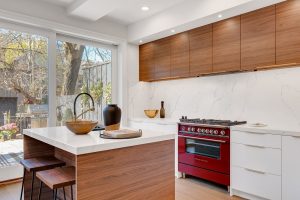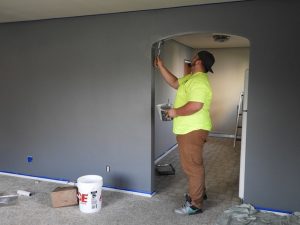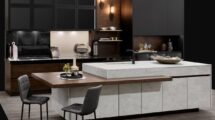Lifescape
By Janet Armstrong,
Certified Interior Designer, CAPS
 In the past, many of us have considered our homes simply a place to rest, relax, dine, and perhaps a place to
In the past, many of us have considered our homes simply a place to rest, relax, dine, and perhaps a place to
entertain friends and family. Our home has always been synonymous with safety and security. But this thinking
has taken on a whole new meaning over the past number of months. Not only are our homes safe havens in
which to rest, relax and dine — but they are now offices, board rooms, classrooms, fitness clubs and/or cottages.
Even with the need for this additional functionality, you still desire spaces that are beautiful, comfortable
and functional. Of course, spending more time in our homes means more wear and tear so finishes and
materials that are durable as well as easy and/or low maintenance are a must! From paint to flooring to counter
finishes, there are products available that make cleaning and maintenance less time intensive yet are key to
creating beautiful spaces.
Paint
 The walls in some areas of a home are subject to a lot of wear and tear and require frequent wiping down
The walls in some areas of a home are subject to a lot of wear and tear and require frequent wiping down
or washing — especially those in kitchens, bathrooms, hallways and entry ways. You want a paint that will
stand up to the frequent washing requirements that these spaces and surfaces demand.
So, what is the difference between washable and scrubbable paint finishes? Washable paint enables
everyday marks to be wiped away with a damp cloth or a light detergent with little effort. If you ‘scrub’ too
much you can wear through the finish, making the surface blemished and the sheen inconsistent on the wall,
requiring touch-ups or a complete repaint. Scrubbable paint, as the name suggests, is more durable and can
withstand more scrubbing — although it does not mean that every stain can be removed.
When updating the various spaces in your home, consider the amount of traffic the room gets, as well as
its function. Typically, entry ways, hallways and trims, doors and baseboards require a scrubbable finish so you
can keep them looking fresh. For kitchens and bathrooms, a washable finish is durable enough to meet the
demands of these rooms and can be easily wiped down.
Counter materials
There has been a trend in recent years to the use of natural stone for counters. While these are uniquely beautiful and create focal points for kitchens, bathrooms or walls, natural stone is high maintenance and actually quite fragile. The good news is there are a number of alternatives available in a variety of colours and patterns that closely resemble stone but are more durable and lower maintenance. Consider the use of one of the following durable, low maintenance products when updating your kitchen or bathrooms.
Quartz
Quartz counters are fabricated by combining approximately 95 per cent ground quartz with polymer resins. The advantages of this product include: doesn’t require sealing; broad range of colours and patterns; non-porous so bacteria resistant; durable; and low maintenance.
Solid surface
This material is manufactured from dense acrylic or polyester or a blend of the two. The seams are fused to make undetectable joints, which works well if you require a large counter or a long section of countertop. And solid-surface sinks are available to match the counters too! The pros of solid surface counters are: low maintenance; wide variety of colour and pattern choices available; non-porous; and, repairable.
Concrete
Concrete has been a popular choice over the past number of years for the following benefits: extremely hard and durable; makes a great work surface; wide range of colors; artistic treatments can be added such as glass, stones, etc.; won’t scratch; and heat resistant.
Flooring
Let’s face it, floors take a beating and can quickly begin to show signs of wear and tear, particularly in high traffic zones. Not only do you want a durable material, but you don’t want to be replacing it very often. These are some options that are long-wearing and will continue to look beautiful in spite of the foot traffic.
Engineered hardwood
The low maintenance of engineered hardwood is hard to beat — simply dry mop or sweep weekly. This flooring is durable and less prone to denting or scratches than softer wood floors. The dense construction of this product also means it can withstand heavy furniture, heat and moisture and won’t expand or shrink from humidity or cold.
DuraCeramic™ tile
DuraCeramic tile is a composite of limestone mixed with a polymeric resin making a product that is flexible and resistant to sub-floor deflection, expansion and contraction. The tiles come in a variety of square and rectangular dimensions and the colours and patterns available appear very similar to ceramic tile. Because of the flex in the tile as well as the warmth and comfort, this is a good product for kitchens where you are standing for long periods of time.
Ceramic tile
Ceramic tile is a very hard and durable product and not suitable for standing on for long periods of time. However, this very feature makes it
resilient and easy to maintain. Sealed tiles are recommended, as they will not stain and the floor can simply be swept and wiped with a damp mop, to keep them looking new.
Luxury vinyl
Luxury vinyl tile (LVT), not to be confused with Vinyl Composite Tile (VCT), is a durable, affordable, low maintenance product that comes in a variety of square and rectangular sizes, as well as colours, patterns and textures. Because of its ‘give,’ LVT is a great option for kitchens. LVT also maintains its shape and size and because of its durability is a good choice for high traffic areas.
Considering the increased activities taking place in our homes and the amount of time we are spending in them, we want to ensure our rooms are functional and comfortable but easily maintained, too. The advice and products presented will help ensure your multi-function home can stand up to the demands placed on it and continue to look beautiful well into the future.
Janet Armstrong (simplyswankdecor.ca) is a graduate of the Interior Design Institute of Canada, CAPS (Certified Aging in Place Specialist) and Chair of the Decorators and Designers Association of Canada (DDA Canada).






